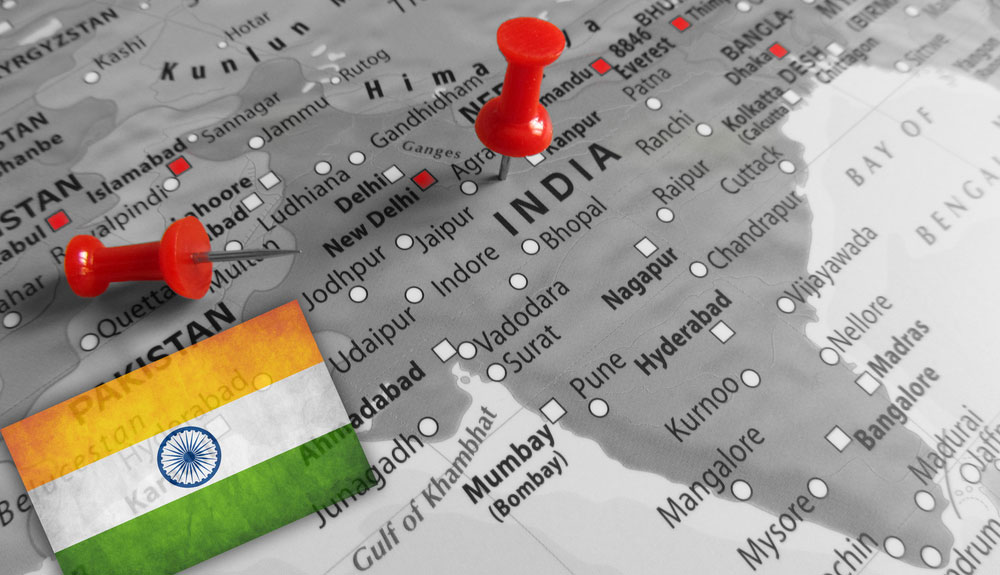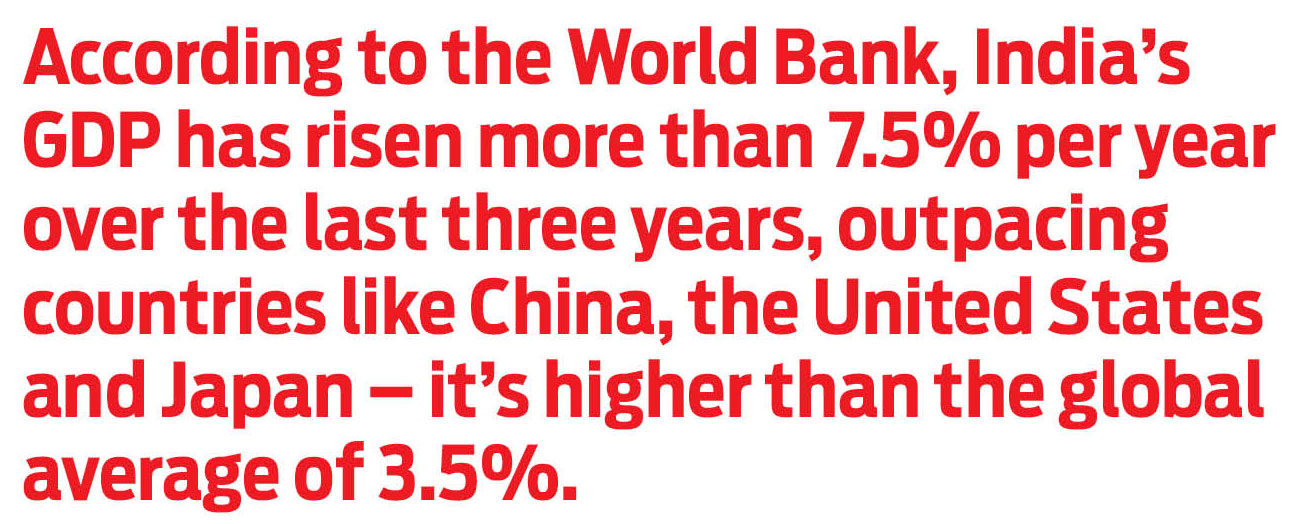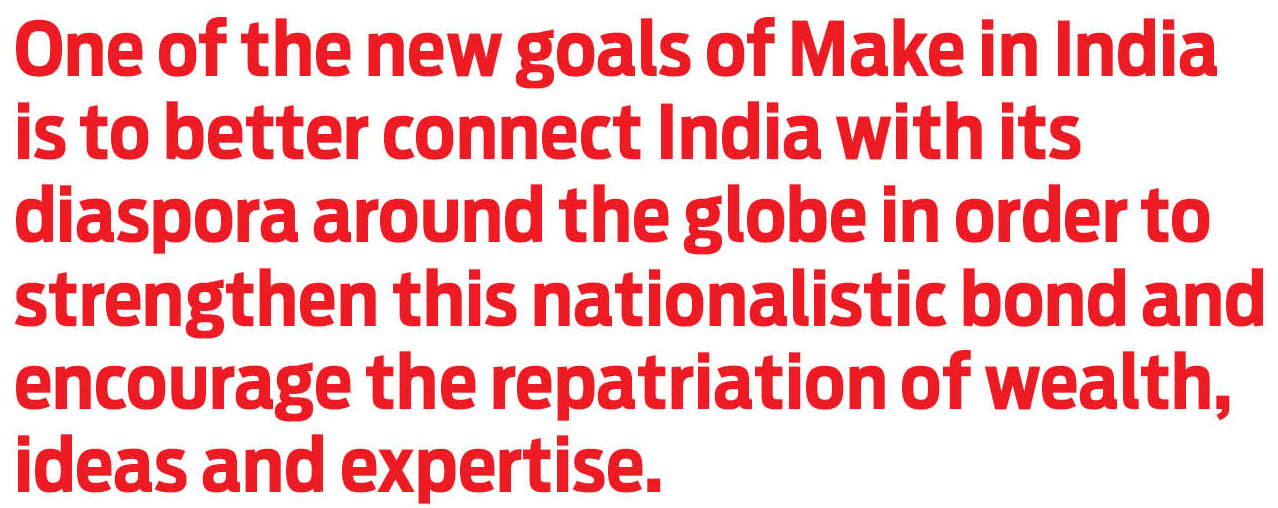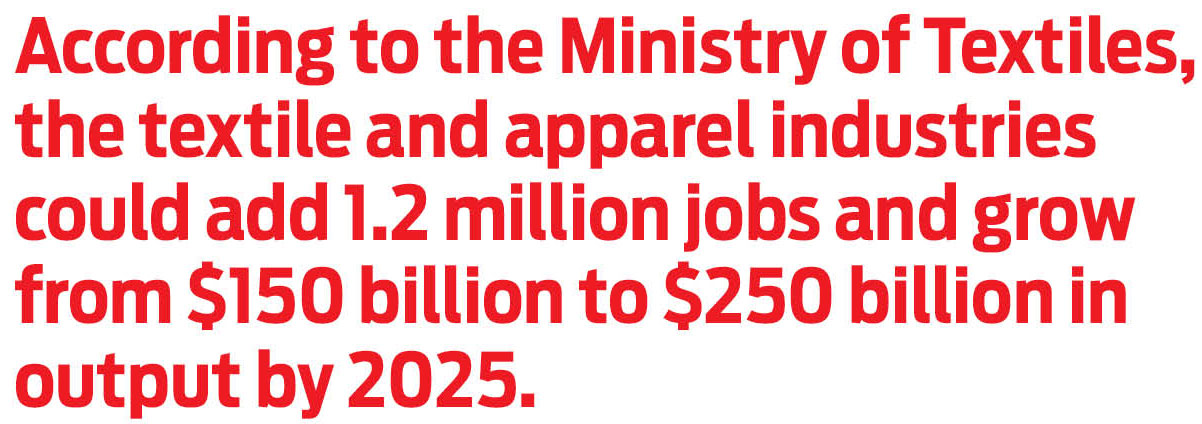Awards March 30, 2018
Growing Pains: India’s Push To 2025
With a dynamic Prime Minister and ambitious goals to revolutionize its manufacturing focus, India is poised to be a major player on the world stage. But can it also handle its pervasive environmental and workforce issues?
Make no mistake: India is growing. Its GDP has been gaining momentum every year, and firms are successfully capturing investment from nations seeking low-cost manufacturing options. Labor-intensive industries like electronics, textile and apparel, automotive and alternative energy are all shifting capacity to India, helping shift its economy away from agriculture and toward manufacturing.

Prime Minister Narendra Modi is leading the charge through a series of high-level economic, political, policy and social initiatives. While Make in India 2025 is the crown jewel, he’s also launched programs like Industry 4.0 and Skills India, all with the hope of bolstering India’s competitiveness with other manufacturing-based countries.
The results of these initiatives have been staggering. According to the World Bank, India’s GDP has risen more than 7.5% per year over the last three years, outpacing countries like China, the United States and Japan – it’s higher than the global average of 3.5%. India’s trade has expanded as well, growing more than two-fold from $299.4 billion in 2006 to $616 billion in 2016. This trend will only continue, as India is negotiating new free-trade agreements, and in a sign of economic advancement, India will also pass an important milestone this year – replacing the United States to become the second largest mobile phone market behind China.
Several independent indicators corroborate this improvement as well: The Heritage Foundation’s Index of Economic Freedom indicates that India’s score has improved from 45% free in 1995 when the rankings first started to more than 54% in 2018. While this is still well below the world average of 61.4%, India has progressed out of the “restrictive” area and is approaching moderately free territory. The World Bank’s Ease of Doing Business Index has also improved markedly, rising almost 9% from 56 in 2017 to 61 in 2018.
Despite this progress, India must confront several challenges. First, they need to improve their manufacturing sector, both in terms of volume and economic value-add. With 12 million new workers joining the labor pool annually, they’ll have to constantly create new opportunities. Second, they must also address environmental degradation, which is evident in its major cities. In fact, 10 of the 20 most polluted cities in the world are in India. And third, India should address concerns about workers’ rights and social advancement, which will continue to weigh on India’s economic progress and global reputation.

The big question is whether India can overcome these challenges and realize Prime Minister Modi’s expansive vision for the country. While the indicators suggest India is on the path to continued economic growth and modernization, this progress is threatened by geopolitical, economic, environmental and labor liabilities.
INDIA’S ECONOMIC INITIATIVES
The crown jewel of India’s economic Initiatives is Make in India 2025. Borne out of the enterprising Modi Administration, Make in India is a multifaceted industrial policy with the ultimate goal to provide employment and economic opportunity for India’s growing workforce. Jeffrey Immelt, former CEO of General Electric, stated, “We believe that Prime Minister Modi’s vision is the right vision, and what we expect is just execution – better execution, more execution, faster execution.”
Make in India has several goals: First, the initiative seeks to inspire greater foreign direct investment in manufacturing by facilitating these investments. In addition, it’s seeking to create manufacturing clusters, similar to the maquiladoras in Mexico. Clusters like this are highly efficient, because they allow for greater industrial coordination, simplified supply chains, and localized expertise; they improve output and efficiency. One of the new goals of Make in India is to better connect India with its diaspora around the globe in order to strengthen this nationalistic bond and encourage the repatriation of wealth, ideas and expertise.
This year, India is preparing to launch Industry 4.0, part two of Prime Minister Modi’s economic plan, which will provide a more targeted approach to advanced industrial development. While Make in India focused on industries like electronics, textiles and apparel and automobiles, 4.0 will focus on sectors like robotics, chemicals, genomics and electrical storage. The Department of Industrial Policy & Promotion (DIPP), which is overseeing 4.0, is trying to push India up the value chain, away from commoditized, low-value-added manufacturing assembly and toward more unique, higher value-added production. To this end, DIPP is ultimately seeking to boost FDI to provide capital and technology to propel these sectors.
Industry 4.0 is also going to target three other problem areas. First, through DIPP, 4.0 will coordinate the proactive search and amendment of national, state and local regulations that are inconsistent with this mission of economic and industrial development. In addition, DIPP is seeking to streamline raw material delivery and logistics for these new industries, coordinate necessary skilled labor and obtain monetary concessions where appropriate. And finally, this initiative is seeking to strengthen infrastructure throughout the country and to the major and developing manufacturing centers.

Another key initiative is Skill India, which Prime Minister Modi launched in 2015. It’s a package of jobs and skills training initiatives with the goal of training 400 million people by 2022. The program will provide financial incentives to Indians who complete certain skills-training programs, with India partnering with private companies to support this mission. For example, Oracle recently opened its largest campus outside the United States in Bengaluru and has established relationships with 2,700 different institutions in India with the capacity to train 500,000 people annually.
India is also pushing several initiatives to curtail environmental degradation. First, there’s a policy shift toward the manufacturing of electric vehicles. Similar to China’s policies, India is seeking to eliminate the manufacturing of the internal combustion engine by 2030. However, policies are not clear. Nicholas Thomas, the Global Director for Nissan’s EV division, said “We’ve had many rounds of discussions with the Indian government on this issue. Though their target of having electric cars by 2030 is very clear, there’s no clear roadmap on how to get there … we need more clarity.” And India missed the December 2017 deadline to promulgate its comprehensive electric vehicle policy, which means many manufacturers will simply postpone investing in the industry.

INDUSTRIAL GROWTH & PROGRESS
These initiatives have been successful in bolstering and growing several industries, including automobiles, textiles, cellphones and solar panels, and created an entrepreneurial class of businesses. Prime Minister Modi has successfully forged international relationships with other countries and multinational corporations, encouraging trade agreements and foreign direct investment. Even Chinese firms are investing in India in hopes of capturing local market share while also seeking low-cost alternatives to its own manufacturing centers.
The automobile sector has been one of the most successful under Prime Minister Modi and his economic initiatives. From 2006 to 2016, the auto industry and its suppliers created more than 25 million jobs, and one of the most high-profile recent examples is Nissan, which is planning to build its least expensive electric car concept in India, costing $10,000. Initially, the car will be sold exclusively in India, but if successful, sales will be expanded to other Asian countries as well.
Another successful example is Ford Motors, which recently completed a 460-acre facility in Sanand, Gujarat, in Northern India. The new facility has the capacity to produce 240,000 vehicles with an additional 270,000 engines. Most importantly, though, is that this project incorporates considerable local production into its supply chain. The facility uses 24 local suppliers, creating the manufacturing ecosystem that was envisioned under Make in India.
Indian firms are also buying international firms as they expand their competitive footprint. In 2008, industrial conglomerate Tata Group bought British nameplates Land Rover and Jaguar from Ford. Indian car company Mahindra recently bought stakes in Korean automaker SsangYong Motor and Italian auto designer Pininfarina, creating a truly global firm.
The textile and apparel industries have expanded considerably over the last several years. According to the Ministry of Textiles, this industry is the second largest employer behind agriculture, with 51 million direct employees and an additional 68 million indirect workers. It also shows some of the greatest promise for job creation and output, especially as China sheds its low-value-added manufacturing to other countries. According to the Ministry of Textiles, the textile and apparel industries could add 1.2 million jobs and grow from $150 billion to $250 billion in output by 2025.
The Indian cellphone industry has received considerable attention over the last several years as manufacturers from around the globe have flocked to India for manufacturing and assembly. According to industry group Broadband India Forum, the cellphone manufacturers have grown to almost 2% of India’s GDP. Companies like HTC, Apple, Samsung, Foxconn and Nokia have all set up manufacturing and assembly facilities in the country. However, most of the activity is low-value-added assembly versus component manufacturing.
Several smaller Chinese manufacturers have set up operations in India as well. HTC, Huawei, Oppo, Xiaomi and Vivo are all operating in India. This investment is not just limited to exports, either. Much of the manufacturing is also being done to access the domestic market. In fact, advertisements for Oppo and Vivo line the streets of Delhi and Mumbai. Vivo, for example, entered into a deal to name a stadium, which was done to likely boost its domestic profile. Oppo is using Bollywood stars in its commercials for domestic appeal.
The solar panel manufacturing industry is becoming an important sector in India. Although it has always been an important sector, it’s become more high profile as Chinese firms have shifted operations to India. For example, Smart Energy Group and Phono Solar (SUMEC) have agreed to set up a joint venture to produce panels both for domestic consumption and export. In another venture, China-based Hareon Solar and Indian Keshav Power have agreed to establish a joint venture to produce solar panels. Most recently – and impressively – Softbank, Foxconn and Bharti are planning to invest approximately $20 billion in different solar power plants throughout the country.

INTERNATIONAL ACHIEVEMENTS
India has made considerable progress and accrued different benefits under different international regimes. First, the United States’ withdrawal from the Trans-Pacific Partnership (TPP) was extremely beneficial for India. Under the original TPP, India would have been excluded from the world’s regional trade agreement, putting it at an extreme disadvantage to countries like Vietnam and Malaysia. Without the United States, the TPP has become a “so what” agreement, lacking the real economic heft of the original.
India is making plenty of progress with its own free-trade regime. It has existing agreements with ASEAN, Sri Lanka, Singapore, Thailand and Malaysia, and is negotiating an agreement with the European Union. Meanwhile, Prime Minister Modi and President Trump have engaged in bilateral discussions on a number of issues, signaling a strengthening relationship between India and the United States.
But India’s growing international presence is not without challenges. India and China remain in an ongoing series of border disputes. During the summer of 2017, the Indian army occupied the Doklam region, which is a contested territory with a competing claim from China. India has also been boycotting China’s One Belt One Road initiative and didn’t attend the recent forum on the subject. While China didn’t publicly protest the snub, privately they were angered at this challenge. India is also concerned about China’s potential for cybercrimes, with recent attacks on various infrastructure systems.
INDIA’S CHALLENGES
India is facing numerous challenges. First, India still lacks the technological capacity to move up the value chain and away from commoditized production. According to the World Economic Forum (WEF) Global Manufacturing Index, India ranks 30th. According to the WEF, countries in the top 25 will be best positioned to respond to changes in manufacturing, especially as automation and artificial intelligence erode traditional sources of employment. This means that countries like India may not participate in the “T-shirt phase” of economic development.
India has a long way to go before it’s a self-sustaining manufacturing behemoth. According to Broadband India Forum, 26.4% of all Indian imports are input components for manufacturing assembly, which strongly suggests they’re not yet advanced, and that they’re relying on the low-value-added and fungible function of assembly for growth. The cellphone and automotive industries are prime examples of this issue.
India’s environmental issues are also posing an increasing challenge. Like China, India’s growth has come at the expense of the environment. According to World Health Organization (WHO), 10 of the 20 world’s most polluted cities are in India, including Delhi at number two. India remains dependent on coal to fuel its industrial growth, which has contributed to air pollution in these cities. India’s rivers are bearing the brunt of this pollution. According to the WHO, 275 of India’s 445 rivers are classified as severely polluted, and over 70% of India’s surface water is contaminated. Delhi has the capacity to treat only half its wastewater, which is further lowered because of intermittent power outages throughout the country.
India will also need to confront several issues related to labor. According to the Global Slavery Index, 36 million people in the world work against their will, and half of this occurs in India. In addition, subsidiary issues like debt bondage and withheld wages also remain problematic throughout the country. While international brands like H&M and PVH can apply pressure to eliminate these issues, domestic brands are less likely to do the same. In addition, income remains low, especially in the textile and apparel industries. For example, the Garment and Textile Workers Union is pushing for higher wages. In response to some of these challenges, the Ministry of Textiles is focusing on bringing back handlooms and fair-trade cotton. It’s also launching Fair Trade India in response to disasters like Rana Plaza and other labor-related abuses emblematic of Southeast Asia.
WHAT’S NEXT
India has considerable potential. As one of the world’s fastest growing economies, it could eventually replace China as the world’s manufacturer as it upgrades its economy and continues to attract considerable foreign investment. According to the Centre for Economics and Business Research in London, India’s economy may surpass the United Kingdom and France next year. However, it must overcome significant obstacles over the next decade to properly position itself as the global economy continues to evolve.
India will confront several challenges as its economy progresses. It will need to encourage more foreign investment and shift its manufacturing up the value chain and away from assembly. In addition, it should immediately address the extreme environmental degradation that has taken place throughout its cities and rivers. Like China, India is going to need to invest tens of billions in cleanup to restore its environment or risk greater harm. And India needs to focus on improving workers’ rights, including addressing issues like slavery.
Under the stewardship of Prime Minister Modi, India will likely be able to navigate these challenges effectively with the firm execution of these varied initiatives. Modi has the political capital, the will and the vision to accomplish it. Time will tell whether India is ready for these changes to become the economic superpower it’s destined to be.
Patrick Gleeson is currently a student at Georgetown University’s McDonough School of Business and is an attorney with global trade policy experience. Previously, he worked for a Washington, D.C.-based advocacy firm, where he focused on free trade agreements and their impact on manufacturing, emerging markets and foreign policy.
